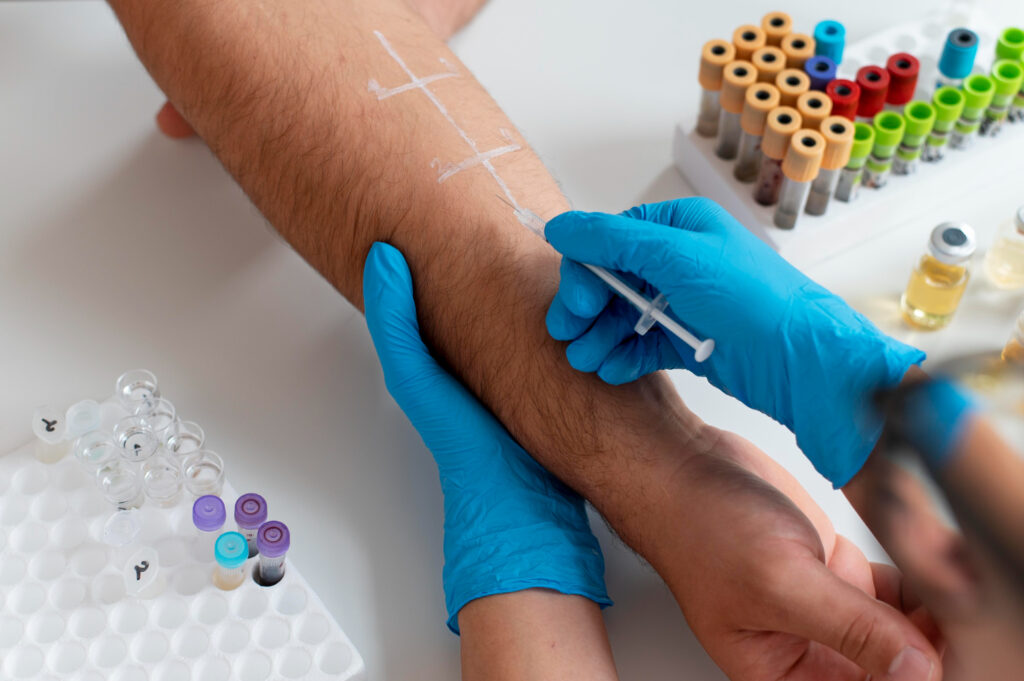
In this article
Initial Consultation
The process of diagnosing allergies begins with a healthcare provider discussing your symptoms and medical history. They will employ various tests and procedures to identify specific allergens causing your reactions. Common allergy tests include skin prick tests, intradermal tests, and blood tests that measure levels of IgE antibodies.
Specialized Care
An allergist immunologist, a specialist in allergies and immune disorders, can offer in-depth diagnosis and treatment, enhancing your quality of life if you suffer from allergies.
Medical History
The first diagnostic step involves collecting detailed information about your personal and family medical history. Allergies often occur alongside other conditions like asthma and are more prevalent in families with a history of allergies. Providers also inquire about recent exposure to potential allergens, which helps narrow down triggers and formulate a treatment plan. Factors like age, occupation, and symptom severity are also considered.
Physical Examination
Healthcare providers conduct physical exams to detect allergy symptoms such as redness, swelling, rashes, and itchy bumps. They also listen to your lungs and examine your nose and throat for respiratory or nasal symptoms. These initial observations guide subsequent allergy testing.
Allergen Testing
Skin Tests
- Skin Prick Testing (SPT): An allergist applies a drop of an allergen to your forearm or back and uses a small probe or needle to scratch the area.
- Intradermal Injection Testing: If SPT results are negative but your medical history suggests a significant environmental allergy, a small amount of allergen is injected under your skin, usually on the forearm.
- Patch Tests: Used to identify allergic contact dermatitis, allergens are taped to your skin for 48 hours. Initial readings are taken when the tape is removed, with final readings 48 hours later.
These skin tests help pinpoint specific allergens, allowing healthcare providers to recommend ways to avoid triggers and prescribe appropriate treatments.
Additional Tests
Spirometry
Spirometry measures lung function to detect signs of airway obstruction or restriction, useful for diagnosing co-existing asthma or COPD. It assesses the volume and speed of air you can exhale, providing insight into lung health.
Challenge Tests
Also known as provocation testing, challenge tests involve gradually administering small amounts of an allergen under medical supervision to observe reactions. This method is particularly effective for diagnosing food allergies and is considered the gold standard for such diagnoses. Challenges are conducted in controlled settings to manage potential anaphylactic reactions.
Screening for Related Conditions
Asthma and COPD often accompany allergies. Spirometry and medical history help rule out or diagnose these conditions. Eczema, a common co-occurring condition, is identified through skin exams. Providers may suggest additional tests to rule out other conditions and confirm an allergy diagnosis.
Summary
Diagnosing allergies involves a comprehensive approach, starting with a detailed medical history and physical exam, followed by various tests to identify specific allergens. Specialized care from an allergist can provide effective management and treatment options, improving your overall quality of life
A Quick Review
Diagnosing allergies involves gathering medical history, conducting physical exams, and performing specific tests like skin prick tests, intradermal injections, and patch tests. Spirometry and challenge tests help identify coexisting conditions like asthma and food allergies. This thorough approach ensures accurate diagnosis and effective treatment.











